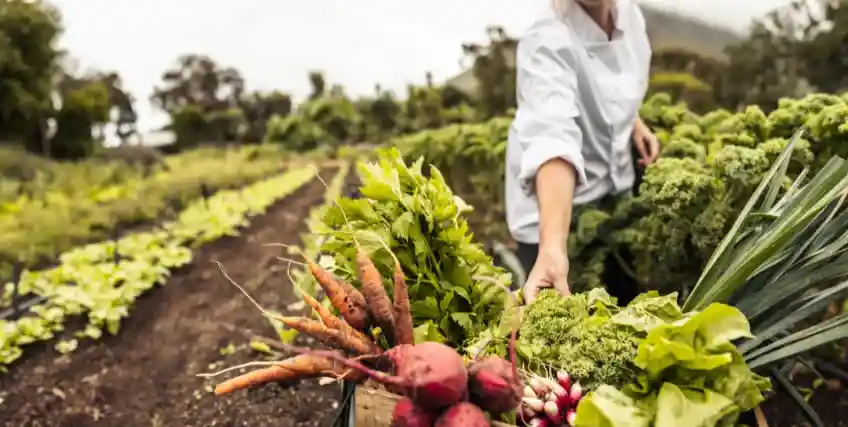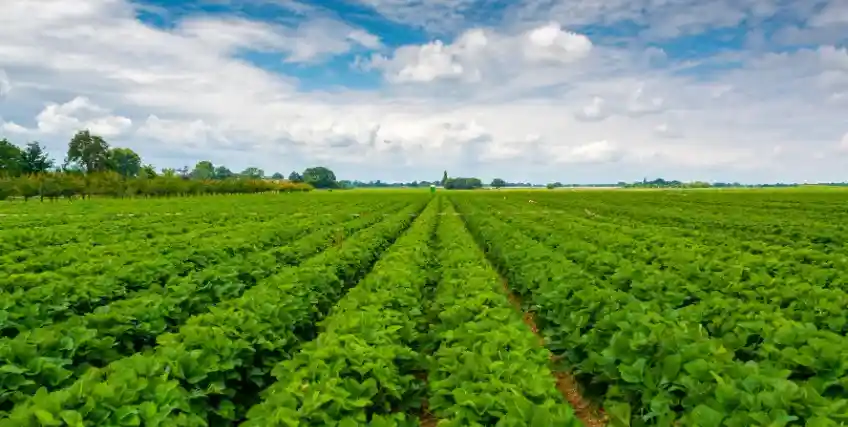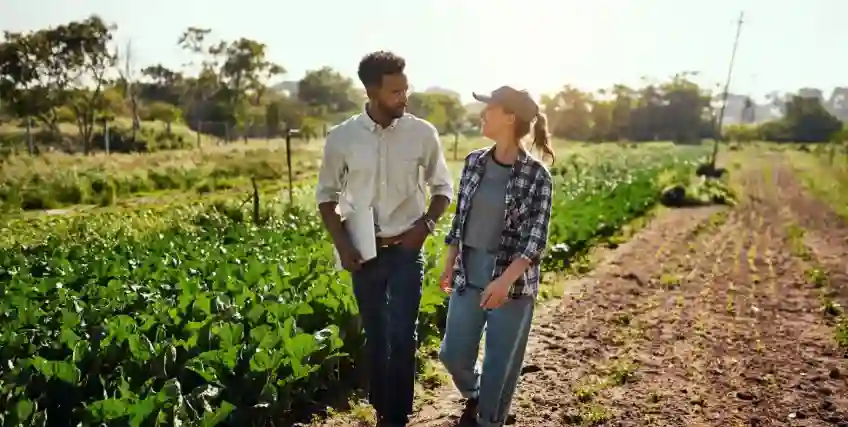Smart Financing Options
For Organic Farms Across the U.S
Looking for Business Financing?
Apply now for flexible business financing. Biz2Credit offers term loans, revenue-based financing, lines of credit, and commercial real estate loans to qualified businesses.
Set up a Biz2Credit account and apply for business financing
Organic farming in the US isn't just a trend anymore. It's a movement. From weekend farmers markets to grocery chains stocking local kale, the shift toward cleaner, sustainable food is real. But the fact is if you're thinking of venturing into organic farming, keep in mind that it is not cheap.
For many organic farmers, accessing a loan for organic farming is what makes the difference between staying small and scaling smart. The upfront costs are steep. Think organic seeds, composting systems, drip irrigation, and the all-too-crucial organic certification. It adds up fast, especially for new farmers or family-run plots.
Sure, there are farm startup grants and even organic farming grants floating around. But let's face it – they're competitive and often slow to disburse. Loans come into play when time is tight and planting season won't wait. A loan for organic farming can help cover equipment upgrades, operating expenses, or that final push to meet USDA certification standards.
The USDA has some programs in place, like microloans and initiatives under the Farm Service Agency (FSA), specifically supporting sustainable agriculture and rural development. Yet most folks still need outside financing to stay afloat.
So if the mission is to feed America clean food and stay in business doing it, access to the right kind of funding – whether it's government grants for organic farming or a well-timed loan for organic farming – becomes vital.
What Is a Loan for Organic Farming?
A loan for organic farming isn't some fancy new financial product. It's just a smarter way for organic farmers to borrow money that aligns with how they work. Unlike traditional farm loans, which can be structured for larger commercial agriculture or big ranches, these loans are more flexible. They're designed with the realities of organic operations in mind.
Some folks use them to get started, others to expand. Whether it's buying land, compost systems, or securing equipment that meets USDA organic standards, it all needs funding. And unless you've got a pile of cash lying around, a loan often steps in.
The USDA and Farm Service Agency (FSA) offer a few loan options. Their direct loans and operating loans support new farmers, especially those focusing on sustainable agriculture. They even look at applicants with limited credit history, which helps with eligibility.
Another plus? Some of these loans offer low-interest terms or delayed payments during tough seasons. And with farming, tough seasons happen, like drought, pest pressure or just bad luck. Keeping cash flow moving can make or break the year.
So yeah, a loan for organic farming isn't just about money. It's about giving organic growers the breathing room to do what they do best, i.e. feed people clean, responsible food without running themselves into the ground financially.
Who Really Needs a Loan for Organic Farming?
Not every farmer needs funding. But for a lot of folks trying to break into or grow in organic farming, a little financial lift goes a long way. Here's who's usually looking for a solid loan for organic farming and why.
1. Beginning Farmers Starting from Scratch
Most beginning farmers aren't inheriting land. They're renting, borrowing, or buying in rural pockets where organic farming is just starting to pick up. The cost of land prep, cover crops, fencing, irrigation and basic equipment adds up fast. For them, a loan for organic farming is usually the only way to get things rolling. Some may also qualify for beginner-friendly options through the USDA's Farm Service Agency or smaller farm ownership loans, but it doesn't always cover everything.
2. Organic Farms Looking to Scale Up
Maybe they've got a few solid seasons under their belt. Sales are up at the farmers market, and local grocers want more produce than they can currently grow. That's when a loan for organic farming can help scale the operation without messing up cash flow. They might use it to add greenhouses, expand land, or transition more acreage to certified organic. It's about growing smart and sustainably without sacrificing the values they started with.
3. Landowners Transitioning to Organic
Plenty of landowners are moving away from conventional ag methods and looking into sustainable agriculture. But going organic isn't instant. There's a 3-year transition period to get organic certification, and the costs during that time can be brutal. A loan for organic farming helps them hang in there financially while they build toward full certification.
4. Ranchers Adding Specialty Crops or Practices
Ranchers who usually focus on livestock are also exploring organic feed, rotational grazing, or adding specialty crops to diversify. But changing operations means added expenses and not all of it's covered by grants or NRCS programs. So many lean on a loan for organic farming to cover fencing, pasture renovation, or even soil testing.
What's a Loan for Organic Farming Used For?
Every organic farm's needs are different. That's the thing — there's no blueprint. But if you look close, some costs show up on just about every farm's balance sheet. That's where a loan for organic farming steps in.
1. Land, Tools, and Infrastructure Fixes
This one's big. A new tractor. A second-hand walk-in cooler. Maybe just money to dig a better well or build a compost shed. These are the basics that keep things running. A loan for organic farming helps farmers afford the infrastructure that powers everything else. Some even go for a USDA-backed farm storage facility loan to store harvested crops safely. Because moldy carrots would mean cash gone.
2. Inputs, Seeds, and Certification Costs
Organic inputs aren't just expensive, they're non-negotiable. Whether it's OMRI-listed fertilizers or heirloom seeds, the costs don't wait. Add in the price of audits and maintaining organic certification, and yeah, you'll feel the heat. A loan for organic farming lets farmers keep their standards high without going broke. There's also the cost share program from USDA that helps, but it rarely covers it all.
3. Managing Risk During Bad Seasons
Weather's brutal. Too much rain, not enough sun. It all messes with planting, harvesting, everything. That's when having extra working capital makes a difference. A loan for organic farming can help pay farmhands, buy mulch, or even pay for crop insurance during rough patches. It's a safety net. Not always pretty, but necessary.
4. Expanding Markets with Value-Added Products
Let's say a farmer wants to make pickles or jams or cold-pressed oils from their own produce. That's value-added production, and it sells like crazy at markets. But turning cucumbers into jars of gourmet pickles? That needs gear, supplies, labels, and permits. A loan for organic farming lets them invest in new income streams without bleeding their main operations dry.
Real Benefits of a Loan for Organic Farming
There's a reason so many organic growers consider a loan for organic farming a core part of their toolkit. It's not just about staying afloat. It's about building something lasting.
1. Stability When Timing is Everything
Farming runs on tight cycles. If your compost isn't ready or your irrigation pump dies mid-season, waiting on a grant isn't an option. A loan for organic farming gives you the flexibility to act fast. It helps stabilize cash flow during crunch time, whether you're seeding a new field or fixing a tractor. Many growers lean on this kind of financial assistance when income only comes in two or three times a year.
2. Freedom to Grow into Bigger Markets
Scaling up isn't just about planting more; it's about selling better. With a well-timed loan for organic farming, small growers can build greenhouses, get proper packaging equipment, or even launch a CSA subscription. That opens doors to more farmers market slots, local stores, and even food co-ops. Without that extra funding, many farms stay stuck in neutral, unable to take the next step.
3. Strengthening the Local Food System
Let's be real. When organic farms thrive, communities eat better. A loan for organic farming helps local producers stay in business, create jobs, and feed neighborhoods. From fresh greens to pasture-raised eggs, this kind of financing supports healthier food systems from the ground up. It's not just a win for one farm. It's a win for everyone around it.
Watch Outs Before You Sign the Dotted Line
Borrowing money isn't always easy or smooth. A loan for organic farming can open doors, sure, but it also comes with a few potholes along the way. Here's what trips people up.
1. Interest Rates Can Sneak Up on You
Sounds obvious, but many borrowers don't fully grasp the long-term hit of even a small percentage hike. Unlike some grant programs, loans have terms and if you miss a payment or fall behind during off-season months, it adds pressure. The best way to deal with this? Read every line. Know the interest rates. Ask questions. This isn't free money and it shouldn't feel like a trap.
2. Access Isn't Always Fair for New Farmers
New farmers don't always have the credit history, business plan, or assets that traditional lenders want to see. So, even if they're growing gorgeous lettuce and doing everything by the book, they still get denied. Some USDA and FSA programs try to fix that, but gaps remain. For many, getting a loan for organic farming feels harder than it should be, especially when they're trying to do things right.
3. Certification Costs Add Up Fast
Getting and keeping organic certification takes money. Audits, inspections, annual renewals - it's all part of the game. If you're not budgeting right, a loan for organic farming can get eaten up quick before you even buy your first seed. And while some cost share programs help, they don't always show up when you need them. Timing is everything here.
4. Loans Aren't Grants
It's easy to confuse the two, especially when folks talk about government grants for organic farming and loan programs in the same breath. But here's the deal: a grant doesn't expect anything back. A loan? It does. A loan for organic farming should fit into a long-term strategy; not a desperate backup plan. Don't take one out unless there's a real path to repay it.
Grants, Programs, and Some Workarounds
Not everyone wants to jump straight into debt. Totally fair. While a loan for organic farming is a strong option, it isn't the only card on the table. Here are a few alternatives and sidekicks that might help lighten the load.
1. USDA's Cost Share Program (OCCSP)
If certification fees are eating into your margins, the Organic Certification Cost Share Program (OCCSP) can help refund up to 75% of those expenses, maxing out at $750 per category. It doesn't replace a loan for organic farming, but it keeps your loan from covering every last penny. Farmers usually apply through their local service center.
2. EQIP, CSP & Conservation Support from NRCS
The Environmental Quality Incentives Program (EQIP) and the Conservation Stewardship Program (CSP) both support conservation practices. These aren't exactly cash-in-hand, but they offer technical help and partial funding for things like cover crops, composting systems, and water conservation. Used smartly, they reduce the need for a bigger loan for organic farming. Plus, they make your land healthier. That's a win.
3. Farm Startup Grants & Organic Farming Grants
There are state-level and nonprofit programs offering farm startup grants and organic farming grants to new growers, especially those in underserved communities. These are limited and often require a strong business plan or co-funding. Still, they're worth digging for. A good grant can delay or reduce your need for a loan for organic farming altogether. Just know you're not the only one applying.
4. Government Grants for Sustainable Farming
Federal and state-level government grants for sustainable farming support long-term environmental impact, often tied to technical assistance, soil health, or water conservation. Some are part of the broader farm bill, others operate under standalone initiatives. They're more likely to back climate-resilient projects than say, buying a tractor. But paired with a loan for organic farming, they cover both growth and responsibility.
5. Microloans, Local Nonprofits & CDFIs
Some community development financial institutions (CDFIs) and rural-focused nonprofits offer microloans for organic producers. These are small, flexible, and sometimes more accessible than mainstream lending. You might not get six figures, but you could get just enough for that hoop house or solar irrigation. A microloan isn't a silver bullet, but when paired with a bigger loan for organic farming, it fills the gaps.
The Road Ahead for Organic Farmers
The future of organic farming in the US? Bright but not without bumps. More consumers want clean food. More grocery chains are stocking local produce. Restaurants are proud to list the name of the farm on the menu. And behind all that, farmers are grinding through long hours, rising costs, and unpredictable weather.
That's where the loan for organic farming comes in. It's not just about keeping things running. It's about staying in the game. From value-added products to multi-season planting, financing gives organic growers a shot at scaling up and not burning out.
But this future depends on support. That means better technical assistance, fairer access to credit, and policies in the next farm bill that prioritize small-scale, regenerative farms. We're seeing increased funding for conservation practices, climate-resilient infrastructure, and risk management tools. If things keep moving that way, the toolbox for organic producers gets bigger and smarter.
At the same time, farmers are learning to mix funding streams. Government grants for sustainable farming might cover the composting bins. A small loan for organic farming pays for staff during harvest. Another program helps install solar panels. It's all puzzle pieces.
So, is the system perfect? Nope. But it's getting better. And for the farmers willing to hustle and adapt, the next few years could be something special.
Trusted by Thousands of Small Business Owners in America.**
Simply because we get what you go through to build a business you believe in.
**Disclaimer: All stories are real, as told by real business owners. Customers do not receive monetary compensation for telling their stories.
From One Entrepreneur to Another: We Get You
We understand what's behind building a business you believe in.
All stories are real, as told by real business owners. Customers do not receive monetary compensation for telling their stories.



Loan for Organic Farming Articles
Financing Your Organic Farm: Loans, Grants, and Tips for Farmers
Organic farming can be a rewarding pursuit if you’re committed to sustainable agriculture, but it often comes with major financial hurdles...
Grants for Organic Farmers Funding Opportunities to Grow Your Farm
Organic farming in the United States continues to grow as one of the thriving sectors. In 2024, organic food sales reached $71.6 billion according to the...
Loan Options for Organic Farming: How to Secure Funding for Your Farm
The organic farming industry is growing rapidly across the United States. Many agricultural producers, ranchers, and organic farmers are turning to sustainable...
Frequently Asked Questions on Loans for Organic Farming
1. What is a loan for organic farming used for?
A loan for organic farming can fund land improvements, irrigation systems, composting setups, equipment, or help cover organic certification and seasonal labor. It bridges cash flow gaps and supports operational upgrades. Unlike organic farming grants, which are limited and competitive, loans give faster access to funding. Farmers often combine both to cover full project costs.
2. Can beginning farmers qualify for a loan for organic farming?
Many programs, especially those from USDA’s Farm Service Agency (FSA), are built for beginning farmers. These may include lower credit requirements and flexible terms. New growers starting out in sustainable agriculture or looking to break into organic farming can often pair loans with farm startup grants to reduce financial strain.
3. How are organic farming grants different from loans?
Organic farming grants don’t need to be paid back. But they’re limited, highly competitive, and come with restrictions. A loan for organic farming, on the other hand, has repayment terms and usually offers more immediate access. Farmers often apply for both: use grants to offset upfront costs, and loans to manage day-to-day expenses.
4. Are there any grants for sustainable or climate-smart practices?
Government grants for sustainable farming, such as EQIP or CSP, fund conservation practices, composting, and water-saving systems. They’re tied to long-term goals like soil health and carbon reduction. While not a replacement for a loan for organic farming, they’re great for offsetting eco-friendly upgrades.
5. Can I apply for both a grant and a loan at the same time?
Yes, and many farmers do. You might use a government grant for organic farming to pay for certification or a hoop house, and a loan for organic farming to manage payroll or buy equipment. Just make sure your business plan reflects how each funding source supports different parts of your operation.



